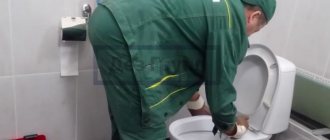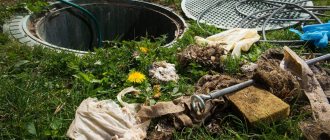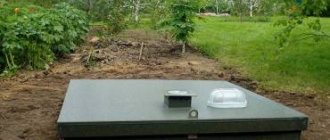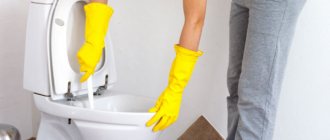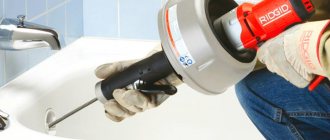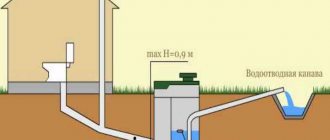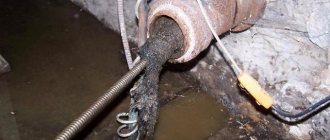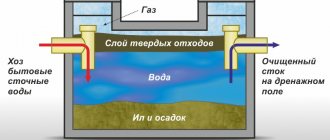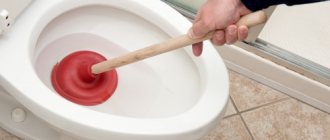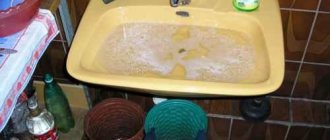How to eliminate fat deposits
A blockage in sewer pipes is an unpleasant phenomenon that adds discomfort when using an apartment or house. The desire to get rid of it as soon as possible is quite understandable. But it is ideal if such a need does not arise, and the owner takes preliminary measures to eliminate fat deposits.
Cleaning sewers from fatty deposits can be done in several ways:
- using improvised means;
- chemicals;
- mechanical means;
- hydrodynamic cleaning.
Each of these methods has its own indications; they have a number of pros and cons.
How to get rid of sludge in a cesspool - effective ways to solve the problem of silting in a cesspool
The question of how to get rid of sludge in a cesspool is far from idle, since siltation of a cesspool is a predictable and inevitable phenomenon. The owner will know that this process has begun by the unpleasant smell emanating from the pit and gradually spreading throughout the entire area. Silty deposits form on its walls, making it difficult for liquid to flow out, which leads to slow cleaning of the sink and toilet in the house. There are several options for solving the problem, but you should not put this issue off for a long time. The pit itself will not clear itself, and its condition will only worsen.
Available means
Improvised means include substances that are likely to be found in every home. As a rule, these are soda, vinegar and citric acid. When water hardly flows into the pipes, before turning to expensive means, it is worth trying to dissolve the fat in the sewer using this simple folk method.
Fighting fat with improvised means
Soda
Baking soda itself can be effective in the fight against fat deposits. Simply pour the glass into the sink drain, fill it with hot water, close the stopper and leave for several hours. This method, unlike the subsequent ones, can be used even for metal pipes.
Soda + vinegar
It will be a little more effective to pour soda not with water, but with vinegar or citric acid. As a result of a chemical reaction, the soda is extinguished, it foams with bubbles, which has a mechanical effect on the deposits, and the excessive pressure of carbon dioxide released during the interaction of substances pushes the blockage. This method is only shown for plastic pipes; metal pipes cannot be cleaned this way: this can cause damage and, as a result, cause corrosion.
You may also like: Cleaning drains using caustic soda - 4 methods
Coca Cola
Another folk remedy for dealing with congestion at home is everyone’s favorite Coca-Cola, Sprite and other drinks. They contain orthophosphoric acid, which is harmless in small quantities, but is good at helping to cope with deposits in pipes. There is only one drawback: the dye in soda can stain white plumbing fixtures, so you should use a colorless drink for sinks.
Chlorine
Another way to clean a sewer pipe from grease is to use products with a high chlorine content. This includes household chemicals, including whiteness. It should be poured in large quantities (sometimes several liters are needed) into the drain and rinsed with plenty of water. On the forums you can also find advice to use hydrochloric acid to remove deposits.
Without expensive chemicals from the store
Sump cleaner
Decomposes waste in cesspools for 6 months
Composite Formula K-47 with high enzymatic activity ensures uninterrupted operation of the sewer system for 6 months. Increases the periods between pumpings and prevents unpleasant odors.
The products are manufactured using original active ingredients from Roebic Lab. USA.
Means for maintenance of cesspools of country toilets. Cesspools require regular treatment due to the accumulation of organic matter, feces, paper, detergents and various chemicals. This leads to overfilling of the tanks, the appearance of an unpleasant odor, deterioration of drainage with subsequent silting of the system. The use of Roetech K-47 eliminates the above problems by quickly decomposing organic waste and other contaminants. Significantly reduces the volume of solids. Eco-friendly, safe
Recommendations for use
1. Shake the bottle well. 2. Pour the contents into the cesspool. 3. Add water if the cesspool is dehydrated.
Repeat 2 times a year or if necessary. The 946 ml bottle serves a 2 m3 tank.
Safe for people, animals, plants.
Keep away from children. Do not take orally.
Decomposes grease, soap, paper in cesspools and septic tanks
High-power Formula K-87 is specially created to break down fats and prevent silting of cesspools, drainage systems and septic tanks.
The products are manufactured using original active ingredients from Roebic Lab. USA.
Solvent for grease, soap, paper, part of the Roebic drainage care program, special agent for decomposition of soap, grease, paper. Roetech K-87 can be used effectively in the maintenance of secondary water systems to dissolve soap, grease and paper in septic tanks and wastewater wells and to restore normal operation of drain pipes by cleaning them from deposits of soap and detergents.
An aqueous suspension based on bacteria of the genus Bacillus subtilis, Bacillis macerans, Bacillus amyloliquefaciens and Bacillus pumilis, which decompose waste harmful to the environment. These bacteria are not pathogenic for humans, animals and plants.
Recommendations for use
1. Shake the bottle well. 2. For drains and risers: for one use, dilute 230 ml of the product with 350 ml of warm (not hot) water and pour into the sink or bathtub. Do not use the system for 6-8 hours. Repeat 4-8 nights in a row.
For septic tanks and drainage fields: Pour the contents into the toilet and flush once. Repeat 4 times a year or as needed.
For best results, apply at night. Do not put in washing machine or dishwasher!
The 946 ml bottle serves a 2 m3 tank.
Safe for people, animals, plants.
Keep away from children. Do not take orally.
Chemicals
The means at hand will help to cope with small deposits, but if they do not help, heavy artillery will be required. Chemicals are the most common and simplest method of combating fat deposits. They are sold as liquid, dry powder, tablets or granules. The latter contain alkali, which makes them most preferable for cleaning pipes. When exposed to warm water, a violent reaction begins, as a result of which the substance affects fat deposits, hair and even food debris, effectively dissolving them. By turning on the water later under high pressure, you can wash the residue down the drain.
It is worth paying attention to products that have an antiseptic effect. Typically they are o. They contain bacteria that fight the cause of unpleasant odors from pipes.
The most popular chemical deposit control agents include:
"Mole"
This is a popular drain grease remover that is relatively inexpensive but quite effective. Available in liquid and dry form, the latter has an antibacterial effect. There are many “Moles” on the market produced by various companies, so the dissolution result may differ slightly, but many again and again prefer this product. The application procedure is simple: pour/pour into the pipe, leave for several hours, rinse with plenty of hot water.
"Mister Muscle"
Available in the form of granules and gel. The gel is thick, penetrates the pipe even in the presence of standing water in the sink and removes the blockage within 15-20 minutes. To do this, pour half the container into the pipe, wait the specified time, open the hot water tap and let it wash away the remaining substance. It must be remembered that it is very caustic and can cause burns to unprotected skin.
"Bagi Pothan"
Treats with a strong, particularly effective product that removes grease and limescale deposits, food waste, and paper. As indicated in the instructions, you can use it to clean the sewer system in an apartment or private house in a few minutes. But it's important to be careful. Open the windows, remove as much water as possible from the sink and pipe before use and add the substance. In this case, it is better to hold the package at arm's length away from you, turning to the side, then pour a glass of hot water into the hole as quickly as possible, without inhaling the steam, and leave for a few minutes. After this, turn on the hot water. The product is very strong and has received mostly positive reviews, but if it does not work the first time, the procedure can be repeated.
"Tiret Turbo"
Quite a well-known brand thanks to advertising. Available in the form of a thick gel that can penetrate the mash even in standing water. Can be used to clean both plastic and metal pipes. Thanks to the composition, it not only removes blockages, but also disinfects pipes, eliminating unpleasant odors. After pouring the product into the hole, wait 5 minutes, then rinse the pipe generously with water. Despite its wide popularity, reviews about the product are mixed.
"Deboucher"
"Deboucher"
A product that will help rid sewer pipes and siphons of fat deposits, food debris, paper, hair and threads. The 1 liter bottle is designed for 2 uses. Half the volume should be poured into the drain hole, allowed to act for 1.5-2 hours, then rinsed with hot water. If the mash is difficult or the pipe is long, it is advised to pour out the full bottle and leave it overnight, then wash the mash with plenty of water. The product does not harm plastic and enamel, but is contraindicated for use in aluminum pipes.
When choosing a product for cleaning sewer pipes from grease, you need to read the instructions: different chemistry is intended for different pipes. One will damage the metal and clean the plastic, the other will make cast iron pipes clean, and plastic pipes will become unusable.
It is important to remember to be careful when using chemicals. Use them only with gloves, and for particularly odorous ones, you can wear a mask. Caustic substances must be kept away from children!
What to do if nothing helps
The first sign of fat accumulation in a cesspool is the appearance of an unpleasant odor. Usually, the solution to the problem begins with calling a sewer, then they use biological substances and, if they turn out to be ineffective, they turn to chemical agents. If even after this the smell does not disappear, the pit has to be cleaned more and more often, which means that we are talking about siltation, and thorough mechanical cleaning will be required.
The operating algorithm is as follows:
- Remove all waste using the services of a vacuum cleaner.
- Using a hose, apply strong water pressure into the empty hole, trying to break up the silty sediment. If the pit becomes very full, you need to pump out the water with a pump or suction pump and repeat the procedure.
- Use any chemical cleaner according to the instructions and clean the pit again with a pump or suction cleaner.
If the cesspool does not have a bottom, you need to clean or update the sand and gravel filter. It is better, of course, to completely remove the contents and replace them with a new one: a layer of sand, a layer of crushed stone or gravel 40 cm thick.
When carrying out mechanical cleaning, you must use a special suit, rubber gloves and a respirator. The best time for manipulation is the end of spring.
For another cleaning method, you will need a cable. You need to put a special rounded brush on it and start moving it through the collector to the septic tank itself. In this case, the work is carried out by two people: one turns the cable, the other pulls it forward. If it starts to move more difficult, you need to make forward and backward movements to break up the fat plug.
Finally, the pipes are washed with plenty of hot water.
Mechanical means
Mechanical cleaning agents are suitable for especially dense, persistent blockages.
The operating principle of the plunger is simple. It needs to be applied to the hole so that the rubber fits tightly to the sink, and with progressive movements to build up pressure in the pipe, it is under its action that the plug is removed. As soon as it becomes sufficient, it will clear the pipe from the most stubborn blockages and grease. In addition, it does not take up much space and can be stored for a long time, waiting in the wings, without being seen.
The most effective method remains a plumbing cable. It comes in lengths from 10 to 50 meters. A stiff brush is attached to one end and a handle to the other. The cable is lowered into the pipe until it hits a blockage, and then they begin to clear it by rotating the handle. Most likely, you will have to make some effort. Remaining deposits should be washed off with plenty of water.
To increase the efficiency of a hand spinner, you can use a drill. This will save effort and time.
To combat particularly difficult congestions, steel belts are used. They are equipped with comfortable handles and different attachments for more efficient work.
Mechanical methods only remove fatty deposits, but do not disinfect pipes. To do this, you should additionally use special tools.
You will find more detailed information about cleaning sewer pipes in the article - How to clean the sewer and remove the blockage with your own hands
Professional cleaning
If it is not possible to deal with the blockage on your own, you can turn to professionals. In their work, specialized services use hydrodynamic devices. They will also help in case of a clogged sewer with a septic tank.
This device is a tube made of thick rubber, at the end of which a special tip is attached. Water is supplied through this tube under high pressure (lower value - 190 MPa), which is distributed using a tip. Water has a very strong effect on deposits, and the long length of the cable allows you to use equipment for cleaning long and hard-to-reach pipes with large diameters, including yard sewerage.
Professional devices also include a machine for removing blockages of drum or sectional types. This is a particularly effective tool for cleaning all types of pipes. A more mobile option is a gasoline-powered machine that can be moved throughout the building and beyond.
Prevention
As you know, it is better not to let a problem arise, but to take care of the condition of the internal sewer pipes in your home regularly. To do this, it is enough to use one sachet of the chemical every 1-3 months. You can even leave it on overnight for the substance to work most effectively. The frequency depends on the intensity of use of the sink.
Also, improvised substances, such as the above-mentioned soda and vinegar, are also a good way to prevent blockages. They cannot cope with serious congestion, but they can easily prevent their occurrence. And further cleaning of the sewer from grease will become much easier.
Since grease forms a film and remains on the walls of pipes at relatively low temperatures, it is best to wash dishes or flush drain pipes with hot water, this will help dissolve the grease. It is advisable to avoid getting solid food debris into the drain, as this will clog it much faster.
Do pipes need to be cleaned of grease?
As it settles on the walls of the sewer, the greasy film gradually becomes thicker and more viscous. It narrows the lumen of the pipe both on its own and due to the fact that various small washable debris gets stuck in it.
In addition, both the oily residues themselves and the food waste remaining there become an excellent breeding ground for bacteria. This is not so much dangerous from the point of view of harm to health, but rather unpleasant, since the pipes begin to smell of rot and rotten meat, they are covered from the inside with a nasty sticky and slimy dark coating.
Therefore, there is only one answer to the question about the need to remove fat - it must be done.

